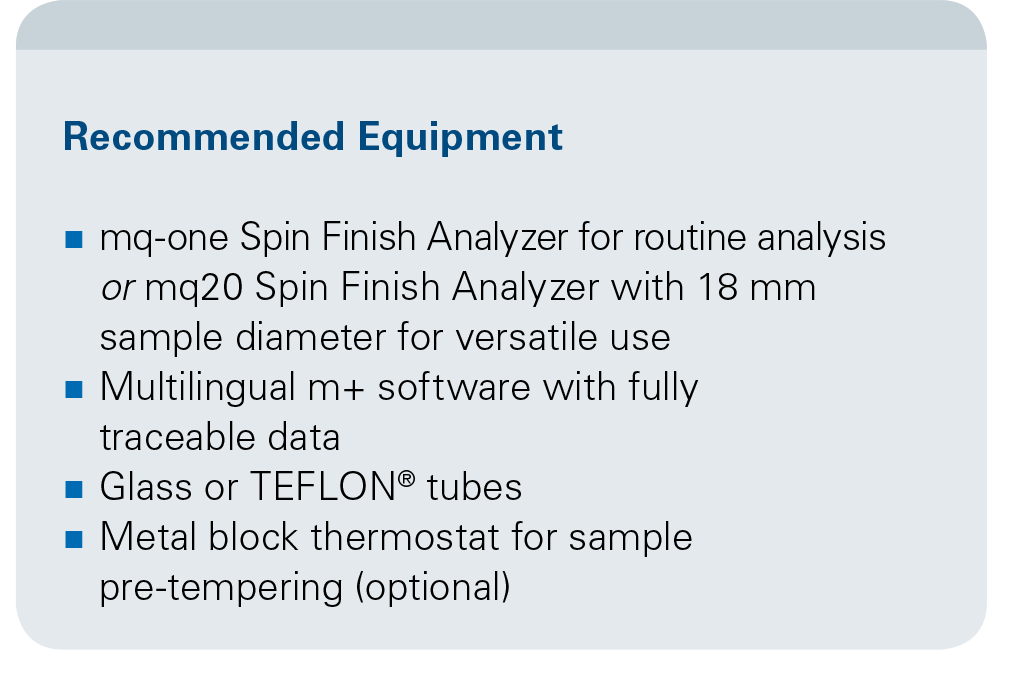Knowledge
Spin Finish on Fibers Oil Pick Up without Sample Weighing

Fiber manufacturing often uses a thin layer of finish to assist the fiber’s performance and spinning processes.
Spin Finish on Fibers Oil Pick Up without Sample Weighing
Fast and Reliable Quality Control
Fiber manufacturing often uses a thin layer of finish to assist the fiber’s performance and its ability to run in downstream spinning processes. This Spin Finish guarantees the lubrication of the fiber surface, the cohesion of filaments, and static protection for the fiber bundle as essential properties in the production of fibers, yarn and non-woven fabrics. The determination of the Spin Finish content by time-domain (TD) NMR is an established method. The most accurate measurement techniques usually require sample weighing (see application note ”Spin Finish on Fibers – Oil Pick Up with Sample Weighing”), which is considered as time consuming.
Features and Benefits
- No sample weighing required
- Very few calibration samples necessary ( 3– 5)
- Independent from sample color, surface or yarn count
- No solvent required
- More reproducible than wet chemistry
Applicable Material
- Technical textile and high performance fibers
- Multi-filament, monofilament, staple fibers,non-woven fabrics, texturized samples
- Polyester, polyamide, polypropylene, polyethylene,polyacrylonitrile fibers and yarns
Application Method
The TD-NMR signal of a fiber sample exhibits different components. Fibers, moisture and Spin Finish are each characterized by a typical decay behavior. The TD-NMR signal of Spin Finish is well separated from the other signals and can be quantitatively analyzed. For the application Spin Finish on Fibers without Sample Weighing, both FID and Hahn echo are recorded. The amplitude of the FID signal (S1) corresponds to the total signal, while the amplitude of the echo signal (S2) relates only to the
Spin Finish component. The ratio of the amplitudes correlates with the Spin Finish concentration. Thus, weighing the sample is not required.
 Note: Make sure to use dry fibers. The average sample mass depends on the kind of fiber and the detection limit on the amount of fibers measured.
Note: Make sure to use dry fibers. The average sample mass depends on the kind of fiber and the detection limit on the amount of fibers measured.
Calibration
Calibration is suitable for the determination of Spin Finish concentrations from 0.5 % to 5 %. It can be done by using well-known reference values (e.g. Spin Finish results from extraction) or by adding defined masses of Spin Finish to a fiber-free of Spin Finish. Alternative calibrations for respective Spin Finish and eventually for respective fibers are recommended, but not necessary in all cases.

Flexibility of Use
The Bruker minispec is capable of running the nonweighing method with very high long-term reliability.The minispec hardware can be applied for both, the weighing and non-weighing method. Thus, the user may run both methods or has the option to swap from one method to the other.


Credit: Bruker
Contact us
388/5 Nuanchan Road, Nuanchan,
Buengkum, Bangkok 10230
0 2363 8585 (auto)
0 2363 8595
081 498 9939






